Technology has become an integral part of modern organizations, transforming the way they operate and interact with their stakeholders.
While technology has brought numerous benefits to organizations, such as increased productivity and inclusivity of services, it has also introduced new challenges that need to be addressed.
I will explore in this article the positive and negative impacts of technology on organizations.

--Advertisement--
Positive Impacts of Technology on Organizations
The use of technology has become an essential part of modern organizations, and its impact on the workplace is undeniable.
From increasing productivity to improving overall well-being, technology has brought about many positive changes in organizations.
Let’s explore the major positive impacts of technology on organizations.

1. Boosted efficiency and productivity
Modern technology tools have transformed the way we work, allowing us to manage our time more effectively and complete tasks faster.
Access to different business technology tools encourages innovation and creativity, which can lead to increased efficiency.
Technology has also led to improvements in productivity, employee satisfaction, and lower enterprise costs. By automating repetitive tasks and streamlining workflows, technology has enabled organizations to focus on higher-value activities that drive growth and profitability.
Overall, the positive effects of technology on businesses are numerous and significant
2. Improved communication and collaboration
Improved communication and collaboration are among the positive impacts of technology on organizations.
Technology has enabled remote communication, which allows employees to work from anywhere and collaborate with colleagues in different locations.
It has also increased collaboration on projects, enabling companies to keep clients updated on project performance and progress.
Technology has revolutionized the way companies conduct business by enabling small businesses to level the playing field with larger organizations.
Collaboration and teamwork generate numerous benefits in the workplace, including improved productivity, better decision-making, and increased innovation.
3. Data-driven decision making
Data-driven decision-making is an important aspect of technology that has a positive impact on organizations. By using data to make decisions, companies can improve their products and services, identify new opportunities, and optimize their operations.
Data-driven decision making also helps organizations gain insights into their customers and market trends, which can lead to better customer experiences and increased revenue.
In higher education, data-driven decision making can help institutions improve student outcomes and streamline administrative processes.
Overall, data-driven decision making is a powerful tool that can help organizations stay competitive in today’s fast-paced business environment.
4. Enhanced customer experience
With the use of technology, companies can improve their customer service and product development.
Emerging technologies such as artificial intelligence, chatbots, and virtual reality are transforming the way businesses interact with customers.
By improving customer experience, companies can increase their bottom line. Digital technologies have also enabled companies to personalize their services and products to meet individual customer needs.
Overall, technology has allowed organizations to better understand and meet the needs of their customers, leading to increased satisfaction and loyalty.
5. Increased flexibility and remote work options
Remote work has been shown to increase employee happiness, loyalty, and productivity. It also provides better work-life balance, timeliness, and reduced absenteeism.
With remote work here to stay, more companies are investing in the systems their workers need for flexible work environments.
Overall, technology has enabled organizations to offer more flexible working arrangements that can benefit both employees and employers.
Negative Impacts of Technology on Organizations:
While technology can increase efficiency and productivity, it can also lead to a decrease in face-to-face communication, hacking and stealing of business data, and safety concerns.
Additionally, technology dependence can lead to reduced interpersonal communication and retraining costs.
Tech-savvy businesspeople understand that the latest apps and gadgets come with both benefits and risks. It is important for organizations to be aware of these negative impacts so they can take steps to mitigate them.
Let’s discuss the major negative impacts of technology on organizations.

1. Increased cyber attack risk
As technology evolves, so do the methods used by cybercriminals to breach security systems and steal sensitive information.
Cyber attacks can cause major damage to businesses, including financial losses, reputational damage, and loss of consumer trust.
The costs associated with cybersecurity technology and expertise, notifying affected parties of a breach, insurance premiums, and public relations support can also be significant.
In addition to financial impacts, cyber attacks on electronic health record systems can also pose a risk to patient privacy and safety.
It is therefore critical for organizations of all sizes to prioritize cybersecurity measures in order to protect themselves from these risks.
2. Dependence on technology
Organizations’ dependence on technology can have negative impacts. Some of these include a decrease in face-to-face communication, the risk of hacking and stealing business data, and the high cost of implementing new technologies.
Additionally, technology can lead to psychological and physical issues such as eyestrain and difficulty focusing on important tasks.
There are also concerns that society as a whole may be too dependent on technology, which can lead to issues such as depression, lack of sleep, ADHD, obesity, and learning barriers.
While technology has undoubtedly made life easier and more convenient, it is important for organizations to be aware of its potential negative impacts and take steps to mitigate them.
3. Job displacement from automation
Automation can lead to the replacement of human workers with machines, resulting in job loss and unemployment.
This displacement effect can also lead to reduced wages and income inequality.
While automation can increase productivity and reduce costs for organizations, it is important to understand its impacts on the workforce and take steps to mitigate negative effects.
Organizations should consider retraining programs for displaced workers, investing in new technologies that complement human skills, and creating new jobs that require uniquely human abilities such as creativity and emotional intelligence.
4. Decreased face-to-face interaction
Studies suggest that technology has a negative effect on both the quality and quantity of face-to-face communication.
This lack of face-to-face interaction can lead to a reduction in relationship building, which is important for team cohesion and collaboration.
Additionally, social media has been found to negatively impact the quality of face-to-face interactions. While digital methods can boost productivity and creativity, it is important for organizations to find a balance between using technology and maintaining meaningful face-to-face interactions.
5. Increased screen time impacts health
Increased screen time can have negative impacts on physical and mental health, which can affect organizations.
Research has shown that excessive screen time can lead to eyestrain, difficulty focusing on important tasks, stress, anxiety, and declining physical health.
These issues can result in decreased productivity and increased absenteeism among employees.
Therefore, organizations should consider implementing policies that limit screen time or encourage breaks from technology to promote the well-being of their employees.
Conclusion on the Positive and Negative Impacts of Technology on Organizations
In conclusion, technology has both positive and negative impacts on organizations. On the positive side, technology has revolutionized the way companies conduct business by enabling small businesses to level the playing field with larger organizations.
It has also helped societies raise productivity, and inclusivity of services, and improve overall well-being.
However, on the negative side, technology can have a negative impact on a business by making communication less human and creating a false sense of knowledge.
Therefore, it is important for organizations to carefully consider the use of technology in their operations and strive to maximize its benefits while minimizing its drawbacks.


